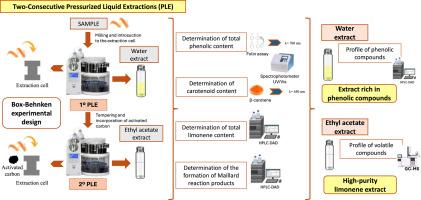两步加压液体萃取:从废桔皮中可持续回收酚类抗氧化剂和高纯度柠檬烯
IF 5.8
2区 化学
Q2 CHEMISTRY, MULTIDISCIPLINARY
引用次数: 0
摘要
本研究提出了一种新的生物精炼方法,利用加压液体萃取(PLE)选择性地回收橘皮废物中的酚类化合物和柠檬烯。采用水萃取多酚,乙酸乙酯萃取柠檬烯的连续两步萃取策略。为了提高提取效率和纯度,采用Box-Behnken设计优化两次连续提取的温度和提取时间。最佳提取条件为水提100°C,乙酸乙酯125°C,每工艺9 min。第一步提取涉及三个静态循环,而在第二步中加入活性炭以减少类胡萝卜素的共提取,得到高纯度的柠檬烯。水萃取物富含黄酮,以其抗氧化和促进健康的特性而闻名,而乙酸乙酯萃取物含有高纯度柠檬烯,不含其他挥发物或萜烯。鉴于其生物活性潜力,柠檬烯在食品、化妆品和生物聚合物中作为石油衍生单体的生物基替代品有着广泛的应用。这种优化的PLE工艺提供了一种快速、高效、环保的传统提取技术替代方案,通过将农业食品垃圾转化为食品、营养保健品、化妆品和生物聚合物行业的高价值生物活性化合物,支持循环经济。本文章由计算机程序翻译,如有差异,请以英文原文为准。

Two-step pressurized liquid extraction: Sustainable recovery of phenolic antioxidants and high-purity limonene from orange peel waste
This study presents a novel biorefinery approach for the sustainable valorization of orange peel waste using pressurized liquid extraction (PLE) to selectively recover phenolic compounds and limonene. A consecutive two-step PLE strategy was developed, employing water for polyphenol extraction followed by ethyl acetate for limonene recovery. To maximize extraction efficiency and purity, a Box-Behnken design was employed to optimize temperature and extraction time of the two consecutive extractions. The optimal PLE extraction conditions were determined as 100 °C for aqueous extraction and 125 °C for ethyl acetate extraction, with 9 min per process. The first extraction involved three static cycles, while activated carbon was incorporated in the second step to minimize carotenoid co-extraction, yielding high-purity limonene. The aqueous extract was rich in flavanones, known for their antioxidant and health-promoting properties, while the ethyl acetate extract contained high-purity limonene, free from other volatiles or terpenes. Given its bioactive potential, limonene has applications in food, cosmetics, and as a bio-based alternative to petroleum-derived monomers in biopolymers. This optimized PLE process provides a rapid, efficient, and environmentally friendly alternative to conventional extraction techniques, supporting the circular economy by transforming agri-food waste into high-value bioactive compounds for food, nutraceutical, cosmetic, and biopolymer industries.
求助全文
通过发布文献求助,成功后即可免费获取论文全文。
去求助
来源期刊

Sustainable Chemistry and Pharmacy
Environmental Science-Pollution
CiteScore
8.20
自引率
6.70%
发文量
274
审稿时长
37 days
期刊介绍:
Sustainable Chemistry and Pharmacy publishes research that is related to chemistry, pharmacy and sustainability science in a forward oriented manner. It provides a unique forum for the publication of innovative research on the intersection and overlap of chemistry and pharmacy on the one hand and sustainability on the other hand. This includes contributions related to increasing sustainability of chemistry and pharmaceutical science and industries itself as well as their products in relation to the contribution of these to sustainability itself. As an interdisciplinary and transdisciplinary journal it addresses all sustainability related issues along the life cycle of chemical and pharmaceutical products form resource related topics until the end of life of products. This includes not only natural science based approaches and issues but also from humanities, social science and economics as far as they are dealing with sustainability related to chemistry and pharmacy. Sustainable Chemistry and Pharmacy aims at bridging between disciplines as well as developing and developed countries.
 求助内容:
求助内容: 应助结果提醒方式:
应助结果提醒方式:


